Estimated reading time: 8 minutes
Raising chickens in the winter can seem challenging, especially for new chicken owners. Cold mornings and less daylight make the wintertime unenjoyable for most people. You walk outside to tend to your chickens and feel frozen immediately.
Just because you are cold and don’t want to be outside doesn’t mean your chickens are too cold. Chickens have a much higher body temperature than humans, ranging from 105 to 107 degrees F. That means they can withstand colder temperatures than humans. In fact, keeping chickens in the summer is actually harder.
Still, chickens do require some special care in the winter, and making sure they are happy is worth it. They will reward you with year-round egg production, although it will decrease. Preparing for winter starts in the summer or fall, and some breeds are hardier than others. So, here are some tips for keeping chickens in the winter.
Want to save this post for later? Click Here to Pin It on Pinterest!
1. Chickens Don’t Need a Heater
Some people consider adding a heater to their chicken coop, but I highly recommend that you don’t. I understand the urge! I live in Ohio, and our winters can be extremely cold. However, chicken coop heaters are a fire hazard. Firefighters respond to chicken coop fires every winter.
Chickens flap around their coop and heaters can accidentally burn their wings. All of the bedding is a fire hazard, so steer clear. Chickens are quite intelligent, and they know to huddle together for warmth. A roost up in the air, where the warm air rises to, combined with appropriate insulation and body heat is all chickens really need.
2. Add More Insulation to Your Chicken Coop
Instead of adding heat, insulation is a better and safer choice. Insulation should be added when you build your chicken coop, but there are ways to add more afterward. You can add cardboard to your coop walls. Another option is placing fitted sheets of insulation to your coop walls. Make sure you cover them with cardboard or something that will stop your chickens from pecking at it.
At the same time, you don’t want to add so much insulation that lack of ventilation becomes a problem. Ventilation is essential for a healthy chicken coop. Without proper air circulation, moisture builds up, leading to ammonia in your coop, and that leads to sick chickens. Never close up the coop completely.
Remember that there is a difference between ventilation and drafts. You don’t want drafts. To avoid this, place any ventilation area above where your chickens roost, ensuring your chickens don’t feel drafts while roosting. At the same time, it ensures air can enter and escape properly.
The best place for these ventilation areas is the space between the walls and roof, covered with hardware cloth. Covering these openings is important because it prevents predators from entering. Raccoons and other predators are intelligent and crafty.
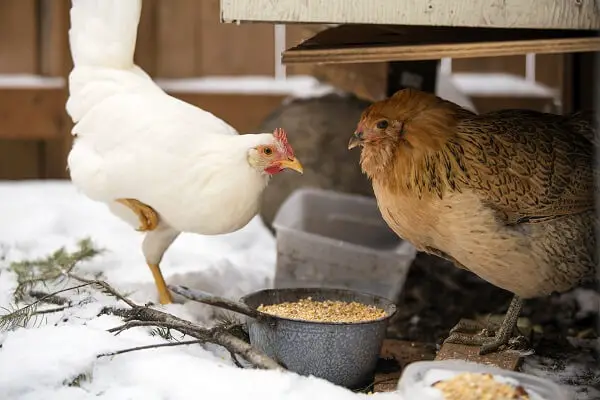
3. Skip the Straw and Hay
Some chicken owners, in hopes of adding more insulation or litter, use bales of straw or hay inside their chicken coop. Regular straw isn’t absorbent, so using straw increases the risk of mold. Mold in your coop can lead to respiratory disease, and no one wants that.
The inside of bales and inside of straw provide the perfect breeding ground for mold and fungus, which endanger the health of your chicken flock. Farmer’s lung is a disease YOU can catch by inhaling mold spores from straw or hay that got wet and dried, causing mildew. It can even harm your health.
4. Watch Their Combs and Wattles
Some chickens have larger combs and wattles, and those breeds are more prone to frostbites. We had a lovely rooster who loved to stand outside, even in the negative temperatures, to crow. Unfortunately, I realized he had frostbite on the tips of his comb when they turned black and eventually fell off. They never grew back either.
Most people have no idea that chickens can get frostbite just like humans. Spread petroleum jelly over their combs and wattles each day when you check their food and water. Frostbite typically won’t kill your chickens, but it can be uncomfortable. Some chickens are smart enough to stay in their protected coop during those excessively cold days, but others are determined.
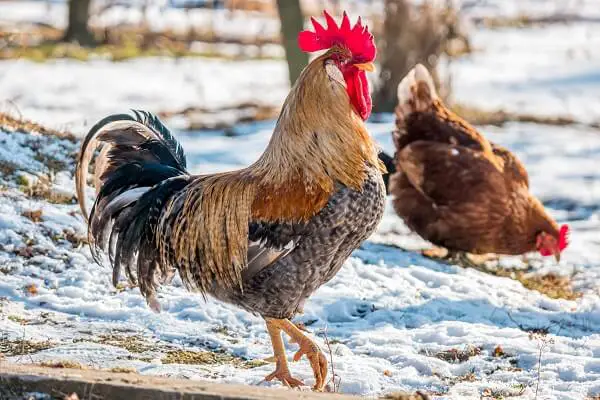
5. Add Boredom Busters
Winter can be boring for everyone, humans and chickens. Chickens need things to do because they spend more time in their coop throughout the winter. Some chicken owners like to hang heads of cabbage from the ceiling as a toy.
Try providing a dust bathing area. Put a tub of sand or wood ash inside the coop. Or you can just put it on the ground inside the coop so the chickens can scratch it up. Add logs, stumps, or branches in your coop and run space for your chickens to hop up on and roost throughout the day.
Spread scratch grains throughout the coop. Try giving your birds treats! There are many different recipes you can try for homemade chicken treats.
6. Keep Their Water Fresh and Unfrozen
The most important and difficult part of taking care of your chickens in the winter is ensuring that they also have fresh unfrozen water. Chicken owners have limited options. You can either buy heated waterers or carry out warm water twice a day, at least.
One of the best options is to use black rubber tubs, which are readily available at any farm and fleet store. The black rubber attracts the sunlight, warming up the tub, which slows the freezing process.
Despite what your neighbor might stay, DON’T keep waterers inside of the coop if possible. Moisture is your enemy during the winter months, and moisture inside a chicken coop can cause health issues.
7. Provide Covered Outside Areas
Chickens want to head outside, but walking in snow isn’t something they enjoy. Most chickens will just stare outside longingly but never step foot in the snow. Give them a covered area outside, so they can go outside, even for the snow haters.
One of the easiest ways to do this is to cover part of the run with a tarp. Unless you want to shovel their run every day, a tarp is the cheapest choice. You can also lay hay and straw on the ground to cover up the snow. If you think about this ahead of time, you can create the entire run with a permanent sheltered area in the run. Chickens like the shade in the summer too.
As the temperatures increase, chickens may start to venture outside without snow protection. Any temperatures below 30 degrees F will be a hard sell for most chickens.
8. Provide Roosting Space
Each chicken needs enough roosting space to stay warm. If you enter a chicken coop at night, you’ll see your entire flock fluffed up together. Roosting together is how chickens stay warm. Warm air rises, so the roost needs to be up off the ground.
Make sure all of your chickens have roosting space. If you see anyone on the ground, it’s a sign you quickly need to add more. The chicken on the ground will be cold and vulnerable to any predators that may be able to enter your coop.
Another important thing to remember is that your chickens’ feet need to stay warm to help them regulate their body temperature, quite like how we need to cover our ears. Make sure you use wide roosts so that the hen can cover her entire feet while roosting.
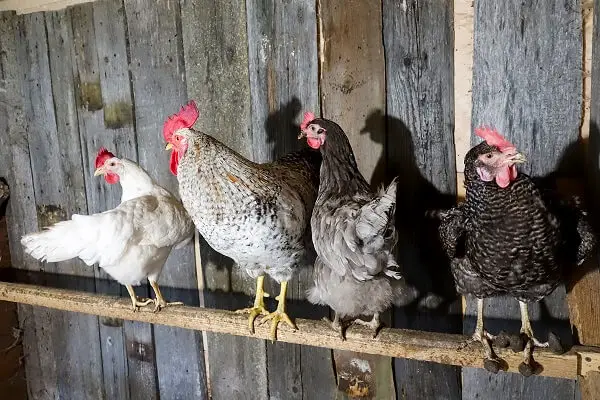
9. Give Greens
Free ranging chickens enjoy fresh greens throughout the summer, but greens are scarce during the winter months. They are unable to forage for anything substantial. Give them safe kitchen scraps as often as you can.
Some chicken owners learn how to grow fodder inside. Fodder is a great supplement for the winter months. Plus, fresh greens boost the quality of your eggs. Here are some other foods to feed your chickens.
10. Give Ample Food
Winter is NOT the time to put your chickens on a diet, not that you ever should do so. Chickens need more food as the temperatures get colder. A full crop keeps them warm when it’s freezing outside. Winter is a good time to increase their feed ration.
You might want to try adding some more high-energy food such as cracked corn and black oil sunflower. These foods will keep your chickens’ crops full.
Keeping Chickens Happy
Chickens handle the winter time fine if they have a properly winterized coop. A well-designed coop with insulation, ventilation, and wide roosts are the basics of what keep your chickens healthy and happy. Remember to provide access all day to fresh, unfrozen water and ample food all day. Your chickens will survive winter with ease and be excited to face the spring and summer.
Like this post? Don't forget to Pin It on Pinterest!

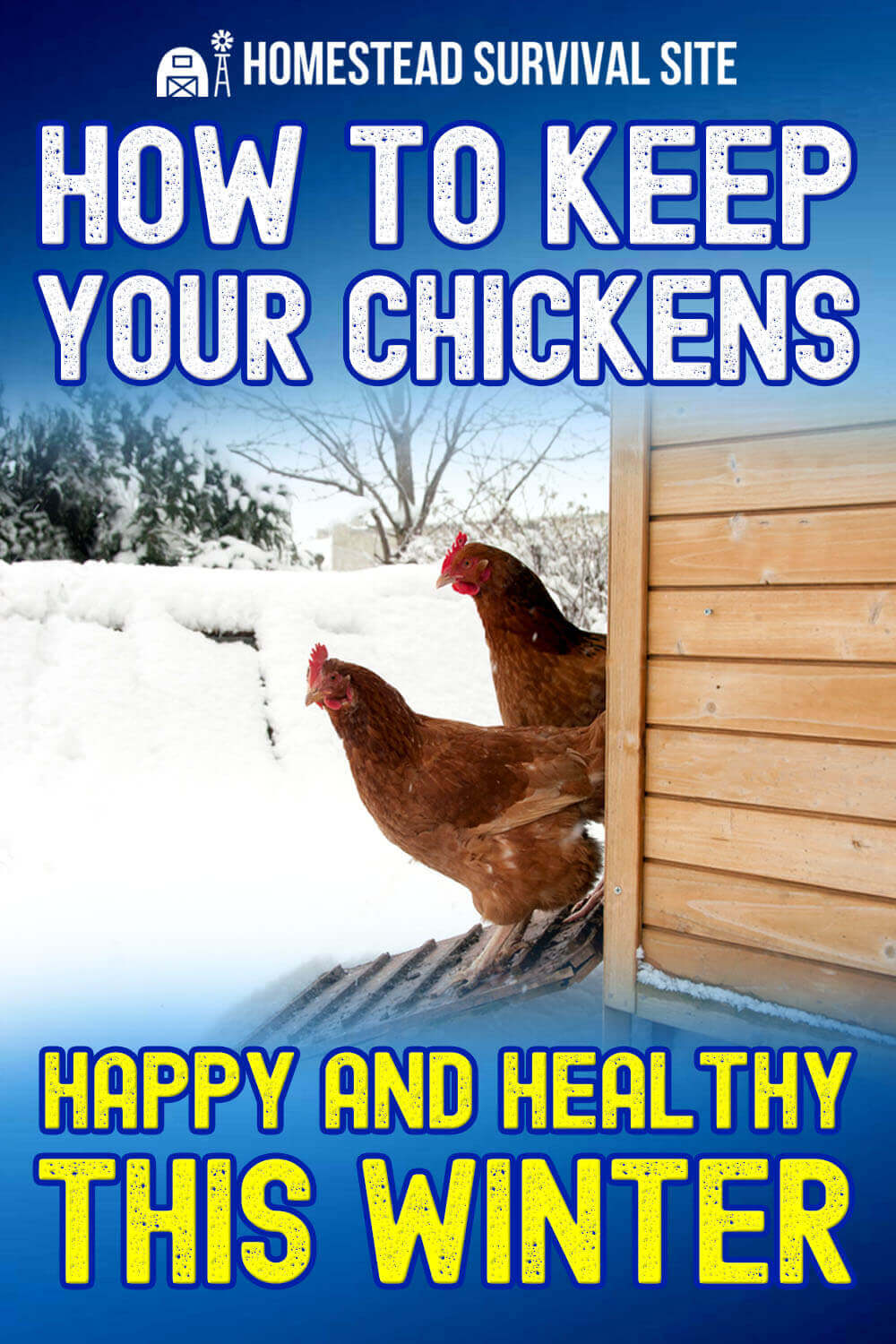


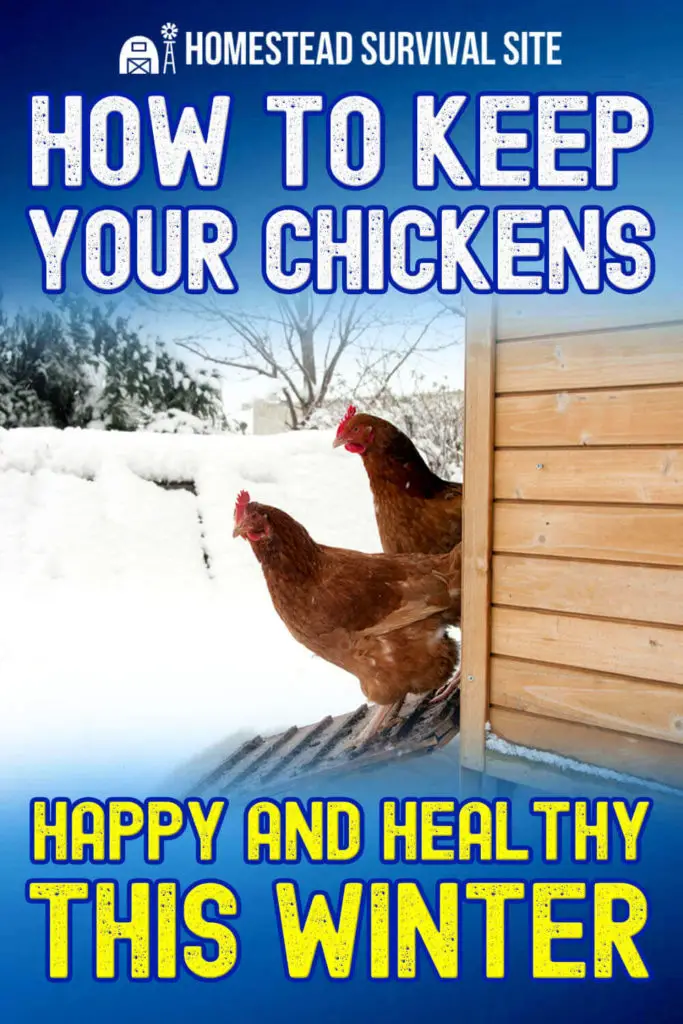




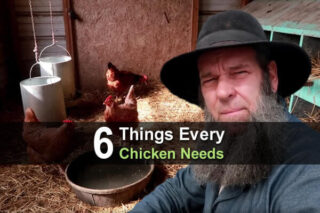
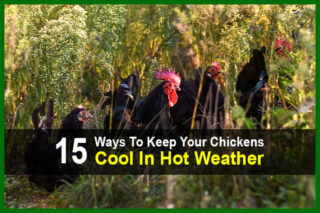


Love the info. I use the big or med. sz heated dog bowl dishes for the wildlife and domestic. I put a good sz rock in it so they can only drink from around the rock and can’t get in the dish. It is easy to hook up to solar as well. Most of the above dishes are blue to dark blue, but If you wanted to I am not sure about painting it black to help get more warmth to it. Maybe setting it inside a black feeder pan would work, do not know. I currently live in AZ now in Zone 7a /7b. But, when I lived in North Central MN the deer sure appreciated the water dish outside in the winter so did the all the other critters including my cats that were outside.